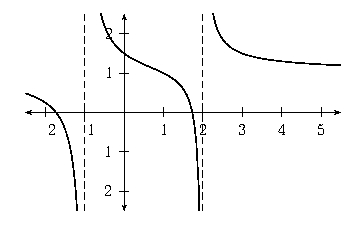Exercise 2.6.6
\[ f(x)=\frac{(x-\sqrt{3})(x+\sqrt{3})}{(x-2)(x+1)} \]
So the \(x\)-intercepts are \((\pm\sqrt{3},0)\) and the vertical asymptotes are at \(2\) and \(-1\). All the intercepts and asymptotes are transitive, so the function changes sign at each intercept and asymptote.
Since \(\dfrac{x^2-3}{x^2-x-2}=1+\dfrac{x-1}{x^2-x-2}\), the quotient is \(1\) and the remainder is \(x-1\). So \(y=1\) is the horizontal asymptote and there is a transitive quotient intercept when \(x-1=0\), so the graph crosses its horizontal asymptote when \(x=1\). The ratio of the leading coefficients is positive, so the graph lies above the \(x\)-axis on the interval \((2,\infty)\).
